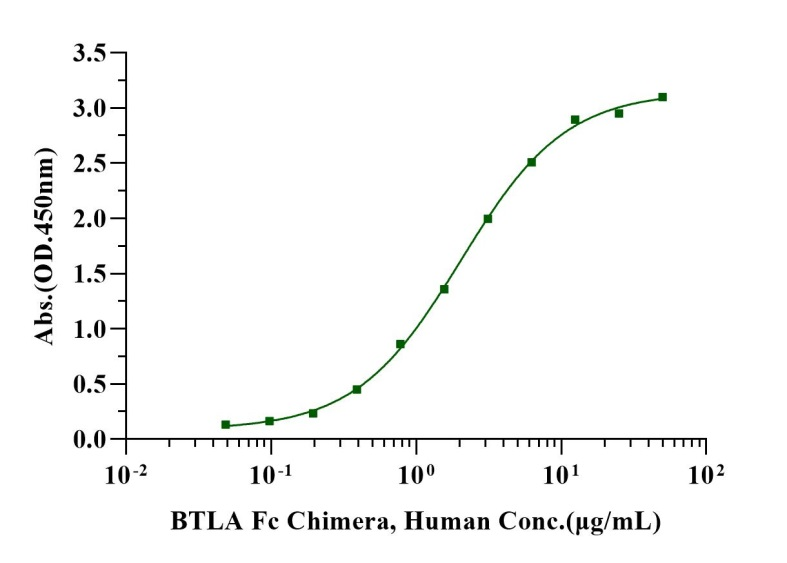Immobilized HVEM/TNFRSF14, Human (Cat. No. UA010658) at 2.0μg/mL (100μL/well) can bind BTLA Fc Chimera, Human
(Cat. No. UA010754) with EC50 of 1.86-2.21 μg/mL.
| Species | Human |
| Synonyms | TNFRSF14,ATAR, HVEA, LIGHTR, TR2, CD270 |
| Accession | Q92956-1 |
| Amino Acid Sequence | Leu39-Val202, with C-terminal His |
| Expression System | HEK293 |
| Molecular Weight | 30-43kDa (Reducing) |
| Purity | >95% by SDS-PAGE |
| Endotoxin | <0.1EU/μg |
| Conjugation | Unconjugated |
| Tag | His Tag |
| Physical Appearance | Lyophilized Powder |
| Storage Buffer | PBS, pH7.4. |
| Reconstitution | Reconstitute at 0.1-1 mg/ml according to the size in ultrapure water after rapid centrifugation. |
| Stability & Storage | · 12 months from date of receipt, lyophilized powder stored at -20 to -80℃. · 3 months, -20 to -80℃ under sterile conditions after reconstitution. · 1 week, 2 to 8℃ under sterile conditions after reconstitution. · Please avoid repeated freeze-thaw cycles. |
| Reference |
1.Steinberg MW, et al. (2008) A crucial role for HVEM and BTLA in preventing intestinal inflammation. J Exp Med. 205(6): 1463-76. 2.Pasero C, et al. (2009) A role for HVEM, but not lymphotoxin-beta receptor, in LIGHT-induced tumor cell death and chemokine production. Eur J Immunol. 39(9): 2502-14. |
Herpesvirus entry mediator (HVEM) is also known as TNFRSF14, TR2 (TNF receptorlike molecule) and ATAR (another TRAF associated receptor), is a type I membrane protein belonging to the TNF/NGF receptor superfamily.It is expressed on many immune cells, including T and B cells, NK cells, monocytes, and neutrophils. Two TNF superfamily ligands lymphotoxin α (TNF-β) and LIGHT (TNFSF14) are identified as cellular ligands for HVEM and initiate the positive signaling. However, recent studies have revealed that HVEM may be viewed as a molecular switch, capable of facilitating both stimulatory and inhibitory cosignaling in T cells. Substantial evidence from both human disease and from experimental mouse models has indicated that dysregulation of the LIGHT-HVEM-BTLA cosignaling pathway can cause inflammation in the lung and in mucosal tissues.

Immobilized HVEM/TNFRSF14, Human (Cat. No. UA010658) at 2.0μg/mL (100μL/well) can bind BTLA Fc Chimera, Human
(Cat. No. UA010754) with EC50 of 1.86-2.21 μg/mL.
1μg (R: reducing condition, N: non-reducing condition).
